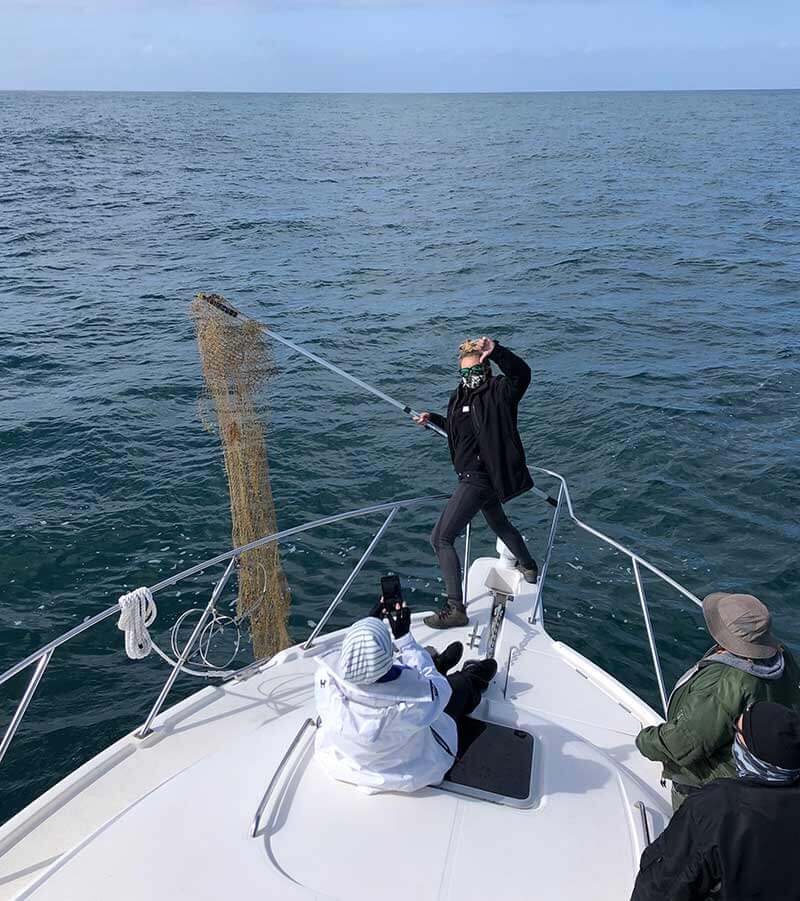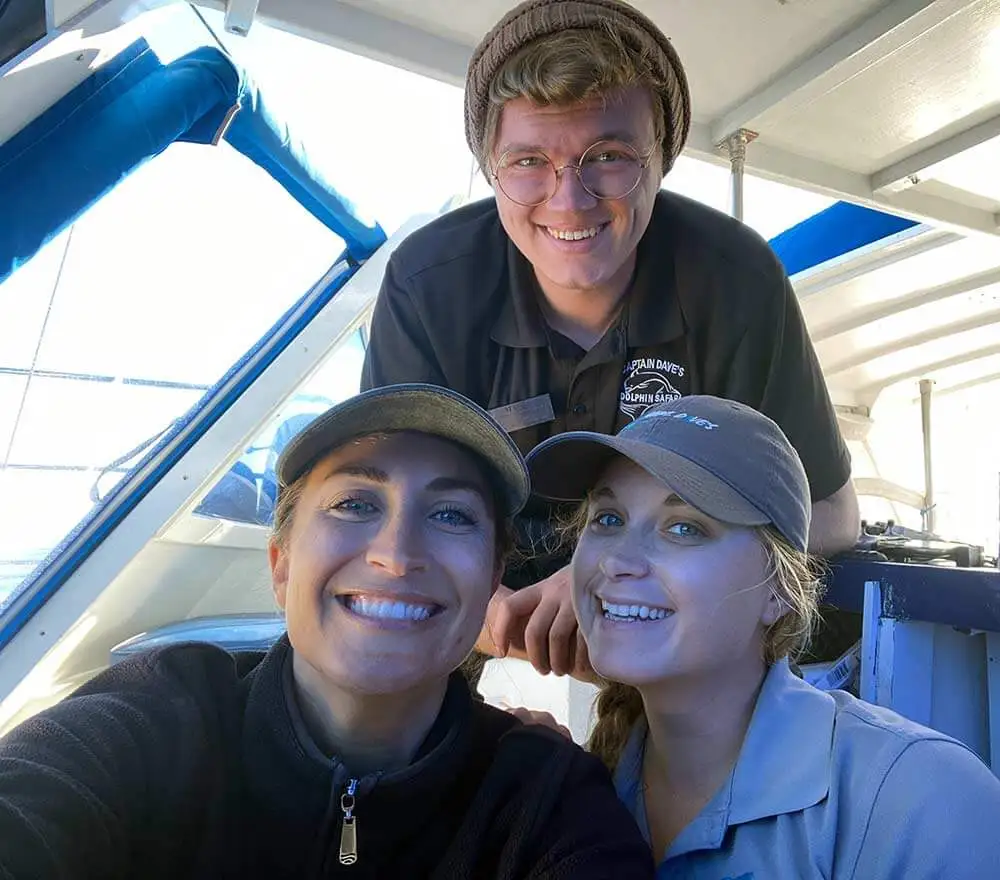What’s it like to be a Marine Naturalist in the Whale Watching Capital of the World

“What is it that you do for work?” A normal question most people get when meeting or getting to know someone for the first time. A small smile always crosses my lips right before I answer, knowing the shocked or confused face that will follow as I answer, “I’m a Marine Mammal Naturalist with Dana Point Whale Watching!” That response typically comes with a response of “What’s that?” or “Wait, you get paid to watch dolphins and whales?!”
In a nutshell, yes! But being a marine naturalist is so much more than being a boat crew member or marine tour guide. Each member of our team brings a diverse variety of knowledge, skills, and passion, to our mission of connecting people with wildlife. While we all come from different backgrounds, we all have one common goal and responsibility with every safari; to educate and empower our guests to fall in love with the marine mammals and their beautiful ocean home! We believe that through storytelling and curating special experiences on our marine tour, guests can take what they’ve learned and change the world, no matter their age!

But what does a day in the life of a marine naturalist look like?
6:00 am
Hit that snooze button a couple of times before dragging myself out of bed. I start my day with the glorious whistles of an Orca pod as my alarm ringtone. Their energetic squeaks have been making me wake up in a panic lately, probably time to change it to a calming humpback song…. alright, can someone bring me a coffee, please?
6:30 am
Let’s get dressed. It’s going to be chilly this morning, and then warmer as the day goes on, so LAYERS, LAYERS, LAYERS. I throw on a beanie and pack a hat to change into later to protect myself from the sun. I clip on a cute pin a fellow marine naturalist made me that says “Trust me, I’m a whale nerd” for a little extra flair.
7 am
Whip up a couple of PB&J’s and sort snacks into little Tupperware containers. Something about being at sea makes you constantly hungry, and today I have a marine tour and a school group booked a private charter, so I’ll need to have plenty of brain fuel. I have been trying to cut back on plastic use, and wrap my sandwiches up in a beeswax wrapper. Our company carries boxed water, so I fill up my reusable water bottle and make a mental note to grab a boxed water from our check-in counter in case I start to run low. The Captain I’m crewing for today has a sweet tooth for Trader Joe’s cookies, so I stash a few of those in my bag as well.
7:30 am
Load up my gear. Every good marine naturalist knows that guests love learning with visuals. Dana Point Whale Watching is located in the dolphin and whale watching capital of the world, and we see a multitude of species year-round! It’s important that I carry field guides, models, and activities so people of all ages can visualize and learn about all the animals we encounter. My favorite teaching tool is a jar full of krill, the favorite snack of blue whales. After guests have looked in the jar and responded with a resounding “YUCK,” they’re amazed that the largest animal on the planet feeds on one of the smallest. Argh! I almost forgot my binoculars – okay we’re outta here!

8 am
As I drive to work, I listen to some of my favorite marine mammal science podcasts. As a marine naturalist, it’s important to stay up to date on the latest science, which requires me to daily seek out recently published research. As our technology advances, and with the expansion of citizen science programs, our understanding of marine mammals is growing each year.
As I park, I take a quick moment to check what our sightings were yesterday, as many guests want to know what we’ve seen on our recent marine tours.
8:45 am
Time to set up the boat. Being a marine naturalist isn’t just observing and teaching about whales and dolphins, there’s some dirty work involved too! But understanding our boat and orientating myself with the safety features is important to making our marine tour a success today.
- Oil level – √
- Transmission fluid – √
- Coolant level – √
- Check fuel level – √
- Check life jackets – √
- Clean heads – √
- Seat cushions out – √
- Windows and countertops wiped – √
- Whalebones and models set out – √
- Keys in and the boat turned on – √
9:30 am
All aboard! Passengers have been loaded and I untie the lines on the dock. I finish covering our safety procedures as we turn out of the channel and into the big ole blue! It’s a gorgeous day and the visibility couldn’t be better. One of the responsibilities of a marine naturalist on a marine tour is to find wildlife for our safari. Our guests are encouraged to help us in the search, and I teach them what to look for; splashing, birds circling or diving, fins, flukes, a back, and of course – a spout!
9:55 am
Woohoo! Thar she blows! A tall column appears on the horizon about 3 miles away. From the shape and height of the blow, and dorsal fin shape, it appears to be a traveling fin whale. One of my favorite parts of being a marine naturalist, is looking for surface behaviors that help identify a whale species even from miles away.
Our Captain spots a second blow on the horizon! It appears that this fin whale is heading towards a pod of dolphins and another feeding whale. From the mushroom-shape of the second whale’s blow and large fluke that raises as it dives, it appears to be a humpback whale feeding with a pod of common dolphin – wow that’s a lot of seabirds and sea lions too; a feeding frenzy!
This is when the real work for a marine naturalist begins. As portions of the animal’s bodies are beneath the surface, it’s my job to clearly describe what they look like and how they explore their environment. Between each surface and magnificently loud spout (yum I think I just tasted some whale snot), I weave a beautiful tale of their natural history and relationship with humans over the centuries. Once, brought to the brink of extinction by whaling, whale populations are slowly rebuilding their populations. My goal is to help guests understand how extraordinary these animals are and how integral they are to the health of the oceans.
YUCK! We pass by derelict fishing gear on the edge of all the feeding wildlife, and I bring attention to it and use the opportunity to talk about how hundreds of thousands of varied marine life die each year from entanglement and bycatch, and that it’s one of the leading causes of death for the whales and dolphins we’re observing. After pulling it onboard with our boat hook, I walk around with it and share the importance of eating sustainably caught seafood. “I had no idea this was such a big problem in the ocean,” one guest remarks as they run their hands over it.

10:45 am
Manute’a is known for its unique underwater viewing pods, so I hand the microphone over to our Captain and begin assisting guests down the ladder. The squeals of delight from someone seeing a dolphin swim by the windows never get old! I explain that the feeding dolphin are coordinating their hunt as a pod, and to listen for their echolocating clicks and whistles as they talk to one another. “I hear them, that’s unbelievable!” they exclaim with joy! On the bow of the boat, the dolphin are bow-riding just beneath the feet of our delighted passengers. “They’re so close, you could almost reach out and touch them,” a man remarks.

11:30 am
Wow what an incredible experience observing this feeding frenzy, some real Planet Earth stuff! The energy on the boat is palpable. Our photographer is sure to snap some shots of the whales to contribute to citizen science research aiming to catalog whale populations through photo identification. Marine tours understand that by being on the ocean every day, we have a unique opportunity to document and report wildlife to scientists gathering data of whale and dolphin sightings, to aid in protecting their populations and habitats.

11:45 am
As we head towards the harbor, I share some more information about everything we saw and answer any questions our guests have. I also take this time to encourage them to take what they learned today, and share it with their community as we work together to create a better world for marine life. We check out the adorable napping sea lions on the buoy, and take a moment to talk about how they differ from seals.
I’ve noticed a 5 year old eyeing our dolphin skull model on the counter, and take it over to her so she can run her fingers over it. She wants to know more about how long mommy and baby dolphins stay together; I can sense a young marine naturalist in the making! Her birthday is coming up in a couple weeks and she wants to have a dolphin birthday party after how much fun today was! I give her parents some information about how to book a private charter, and what a unique and memorable experience it is!
12 pm
We’re back on the dock. “I cried like three times, that was MAGICAL!” a passenger offloading exclaims with delight. With that, I know I’ve done my job. People protect what they love, and I believe our guests are walking away with a new understanding and appreciation of our beautiful blue planet.
12:10 pm
Quick tidy and wipe down, and it’s time for lunch! Our crew enjoys looking over our photographer and drone pilot’s best shots, and agree that we can’t wait to get back out there for our next trip, a private tour with a group of school children.

8 pm
With a big yawn I feel a slight tinge on my face…not enough sunscreen again today, whoops! It’s been an amazingly day though. I reflect back on the conversations I had today with our guests. “How long does a Western Gull live?” Ah yes, the question I didn’t know the answer to today; I make a mental note to look it up on my phone once I’m snuggled in bed. Like I said, always learning!
After a hearty dinner it’s off to bed so we can do it all again tomorrow. There’s no counting sheep for a marine naturalist, so with my eyes closed I count breaching Risso’s dolphin and drift off into a whale-filled dreamy sleep.
Want to become a marine naturalist with Dana Point whale watching? We love to talk about our careers, feel free to engage with any of our crew out on the water for more information about how to get started in this field.
Until then,
Hannah Rich
First Mate and Marine Naturalist
Capt. Dave’s Dolphin & Whale Watching Safari
